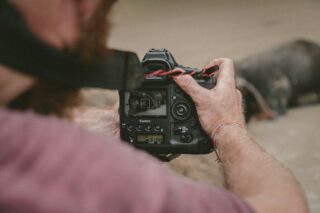what equipment is needed for video production ?
Read on for a more in-depth look at people’s motivations for watching travel videos. Are you new to video production or are you looking to produce your first ever film? There is more that goes into film than the concept. In fact, having the correct equipment to bring your concept to life is imperative.
So, what equipment is needed for video production?
The top 10 pieces of video production equipment you need include:
- Video Camera
- Tripod
- Camera
- Lenses
- Microphones
- Audio Cables
- Headphones
- Lighting Equipment
- Video Editing Software
- Additional Batteries
- Additional Memory Cards
Keep reading to find our recommendations of important video production equipment for your next project.
Top 12 video production equipment
Video production is a great tool for increasing brand awareness but getting started with creating your own video can be a little daunting if you don’t know what equipment you need. In the current digital climate, creating videos that are high quality is non-negotiable. Therefore, we have put together a detailed guide of video production equipment that you need to produce high-quality video content.
1. video cameras
This may seem obvious but the most important part of video production is ensuring you have a suitable video camera. It is important to keep in mind the type of video you are producing when considering how you are going to film your video. For example, if you are simply creating social media content, a top range mobile phone most likely has the camera quality that you require. Whereas, if you are looking to film a brand film for your business, you may want something a little higher spec such as a video camera.
2. tripod:
After choosing your video camera, we highly recommend selecting a tripod for your video production. A tripod is important for ensuring your camera is steady when panning across in clips which creates a seamless result. The main reasons you need a tripod when filming a video include:
Precision – As mentioned before, the main reason for using a tripod is precision. You want your video to be seen as professional, therefore ensuring a steady and smooth panning action is important.
Consistency – Another benefit of a tripod is that it allows you to maintain consistency throughout framing. You won’t need to constantly check your height when moving from scene to scene.
Hands-Free Operation – A tripod also allows hands-free operation. This means that you will be more free to adjust props, lighting and other equipment.
Other than tripods, there is a range of different equipment on the market to help with filming using a camera. Examples include:
- Dolly Track
- Gimbals
- Jimmy
- Jibs
- Sliders
- Easy Rig
3. camera lenses:
Camera lenses are also an important piece of equipment when producing a film. Typically there are two types of lenses used: prime lenses and zoom lenses. Depending on the type of scene you are filming, you may want both types of lenses available so you can get fixed and zoomed in at angles. The main types of lenses you can expect to find on the market include:
- Standard Lenses – This type of lens has a perspective close to the human eye and is therefore good for everyday scenes and general videography.
- Wide Angle Lenses – Wide-angle lenses are ideal for filming large landscapes or any places you want to emphasise the environment.
- Macro Lenses – If you are looking for a detailed, close-up shot then a macro lens is what you need.
- Telephoto Lens – This type of lens is ideal for when you want to focus on something from far away.
- Spherical Prime Lenses – Produces uncompressed, sharp images of superior quality for film making.
- Spherical Zooms – These are ideal for capturing detailed, high resolution footage even when zooming in.
- Anamorphic Primes – These lenses deliver high contrast resolution and consistent colour balancing between focal lengths.
- Anamorphic Zooms – These lenses will provide a 2x zoom to footage, but will not produce the same extreme anamorphic flares or bokeh traditional among the native anamorphic.
- Vintage Lenses – Many vintage lenses are blurred towards the edge of the frame to create a vintage visual effect when shooting footage.
- Specialty Lenses like a Probe Lens – Probe lenses allow you to capture very small objects up close.
4. filters:
Lens filters are another essential piece of kit for film production. Some lens filters can help to remove unnecessary reflections which negatively affect the quality of film. Others can enhance certain colours in a set which can be good for portraying a particular mood or style of film. There are even some filters that limit the amount of light that travels through the lens. Having a variety of filters on set can help you be more creative with your film production and trial different styles to see what works for you.
5. matte box:
A matte box is an essential tool for film production as it helps you to manipulate the light that comes into your lens. By doing so you can experience the following benefits:
- Filtration – This shapes your image, due to the matte box helping to keep it neatly in front of your lens.
- Restricts Unwanted Light – They are also ideal for blocking unwanted light which means you have maximum control over the light hitting the lens.
- Safety – They also act as a way of protecting your camera and lens.
6. microphone:
We all know that sound quality is an important factor in film production. Therefore, choosing the right microphone should be a priority to you. There are a variety of microphones available, so it is vital that you choose the one that meets the needs of your project.
- Boom Microphone – This type of microphone is ideal for recording audio in big groups where there are multiple people.
- Handheld Microphone – If your video production is fast-paced and on the go, a handheld microphone is what you need.
- Wireless Microphone – A wireless microphone can be a good option for maintaining sound quality when you don’t have someone to hold a boom.
- Shotgun Microphone – If you are looking to isolate precise sounds, then a shotgun microphone is perfect for your project.
7. audio cables:
Whilst probably not the most interesting piece of video production equipment, audio cables are important for connecting different devices, such as your camera and your microphone. Different types of audio cables that you may need include:
- USB – This cable is required for you to link your camera to your computer for the editing process.
- HDMI – These cables are compatible with most cameras and can be used to project video onto other screens.
- MIDI – These cables are important when you are adding musical instruments into your video content.
- XLR – This audio cable is required when you want to enhance audio quality by balancing your audio signal.
8. headphones:
Headphones are a key piece of equipment for video production because they allow you to monitor audio as you are filming. This can help with any major audio issues being identified before you get back to the editing stage. Some other functions of headphones include:
- Quality Control – Headphones can help detect audio issues that can be fixed on set rather than in the post-production process which can be more time-consuming.
- Audio Level Monitoring – Using headphones to monitor audio levels means that you can ensure a consistent quality throughout the video.
- Directional Audio – In the instances where you are recording multiple types of audio in one film, headphones can help you to identify whether there is any interference between microphones.
9. lighting equipment:
Lighting equipment can take a scene from looking dull to illuminated which can elevate a filming set when done properly. There are a lot of different lighting tools to choose from. We have detailed some below for your benefit:
- Continuous Lights – Lights such as tungsten or fluorescent lights are great for when you want to maintain a constant light source on a scene.
- Reflectors – These are useful for bouncing light into specific places to lighten shadows.
- Flash-lighting – This type of lighting equipment can offer flashes of light and intensity for specific moments. Some can even be controlled remotely.
- Softboxes – These types of lights are a good tool for softening harsh light and reducing shadows.
- Spotlights – When you want to put emphasis on something or create dramatic effect, spotlights are perfect.
- LED lights – These lights are ideal for creating different moods on set and can be controlled remotely.
- HMIs – These lights are good for filming outside due to their high output and colour accuracy.
- Tungsten Lights – This type of lighting can be dimmed which makes them good for adjusting mood and light intensity throughout filming.
- RGB Lights – They generate different lighting effects with the colours red, green and blue.
10. video editing software:
Video editing software is still an important tool in video production and should be added to your equipment list. Without it, you will have all the footage and audio, but not have the tools to make the necessary edits to bring the film together. There are many different NLE (non-linear) editing software available. Here are some of our recommendations:
11. additional batteries:
It may be considered obvious, but ensuring you have additional batteries before you go filming is key to ensuring you can have a full day filming. The last thing you want is for your day to be cut short by cameras or other equipment running out of battery.
What’s more, if you are recording with a higher frame rate and resolution, you may find that your camera batteries run out quicker anyway. Therefore, being more organised and having backup batteries is only going to benefit you.
12. additional memory cards:
Similar to batteries, memory cards can also get used up during long filming sessions, so we recommend you take spare ones. It is advised to invest in faster memory cards because these are better for recording video footage, unlike others which are only really good for images. But overall, ensuring you have spare memory cards on hand for your day of filming is key.
Video production at dot films
As you can see, there is a lot of equipment required for filming even some of the most basic films and this can be quite costly, time-consuming and require a certain skill set. Dot Films has an array of experience filming high-quality film productions and using a variety of equipment to create different effects. Save yourself time and money by trusting Dot Films to produce your film.
Contact us to discuss your video production idea.
share



